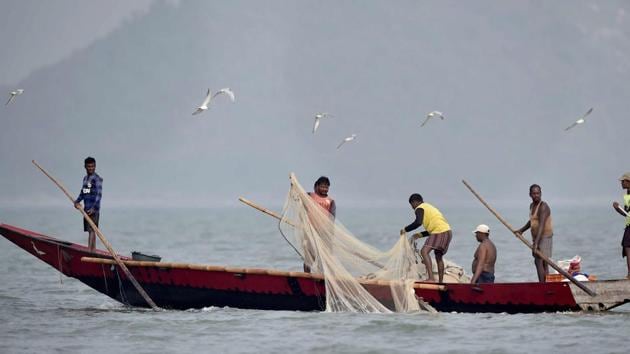146 dolphins sighted in Chilika lake’s annual census, populating new areas
Of the six varieties of dolphins that are found in India’s rivers, lakes and around coastline, the Irrawaddy Dolphins are among the lowest in number.
In what could be a sign of the fast-improving ecosystem of Odisha’s Chilika lake, India’s largest brackish water lagoon, endangered Irrawaddy Dolphins are now populating newer areas of the 1165 sq km water body, Odisha wildlife officials said.

Chilika is the single largest habitat of the slow-swimming dolphins in the world that got their names from Irrawaddy river in Myanmar where they were first sighted. These dolphins, measuring anywhere between 6 and 9 feet, have a bulging forehead, short beak, and 12-19 teeth on each side of both jaws. They are categorised as Schedule-I animal under the Wildlife Protection Act, 1972.
In the annual dolphin census conducted by state wildlife official and wildlife researchers on Sunday, at least 146 Irrawaddy Dolphins were sighted.
“The direct sighting of 146 dolphins proves that the aquatic mammals are colonising new areas in central and southern parts of the lake where they were not seen before. The dolphins were earlier seen only in Satpada area, but now they are being seen in areas near Kalijai and Rambha. Removal of obstructions like prawn gherries (netted enclosures in the lake for cultivation of shrimps) in the lake may have helped. There are tell-tale signs of the dolphins migrating from Satpada side to other areas. Once they get bigger area, then the population may increase in next couple of years,” said Sushanta Nanda, chief executive officer of Chilika Development Authority.
CDA officials said the estimated population of the dolphins in the lake would be anywhere between 133 and 172.
The hydrophone monitoring carried out round the year in Chilika showed that the highest number of dolphins (20-25) was around Rajhans, followed by the Magarmukh and Malatikuda areas. As dolphins use echolocation to navigate through the turbid waters, scientists use hydrophones to locate their presence.
Though around six varieties of dolphins are found in India’s rivers, lakes and around coastline, wildlife researchers say so far there is certainty about the numbers of Gangetic river dolphins and Irrawaddy dolphins only. “No proper survey of other dolphins have been done so far. By sheer numbers, the Gangetic river dolphins would be the highest with number ranging between 3300 and 3500. The Gangetic river dolphins are freshwater species that are found in the Sundarban river system and Brahmaputra rivers. On the other hand, the Irrawaddy Dolphins are found mostly in brackish water zones and that too in Chilika,” said Dr Ravindra Sinha, vice chancellor of Shri Mata Vaishno Devi University, and India’s foremost expert on dolphins.
Sinha agreed that the increased sightings of dolphins was a good sign of the lake’s improved ecosystem. “In early 2000, when the lake’s salinity had gone down due to closing of the mouth, the number of Irrawaddy dolphins were much less than 100,” he said.
Wildlife officials said freeing a large part of the lake from the net enclosures had not just led to migration of dolphins to newer areas, but was also reflected in increased congregation of migratory birds in the lake this year. Earlier this month, at least 11 lakh birds belonging to 184 species were counted in the lake, an all-time high.
Conservationists, however, said the sightings of dolphins in newer areas may not mean anything for the mammals considering they way tourists were hounding them out for a better view.
“Let’s get this clear. The dolphins in the lake are under stress due to motorboats with their propellers churning the water enough to disturb them. At least 50 per cent of the dolphins in the lake are being chased around by visitors who want to photograph. The boats would encircle a school of dolphin causing them unimaginable stress. How would they breed under these stressful conditions,” asked Mohanty, Odisha’s noted wildlife conservationist.
Mohanty said the lake authorities should not allow boats that travel at more than 3 km per hour. “The dolphins have the first priority over the lake and not the tourists,” said Mohanty.






